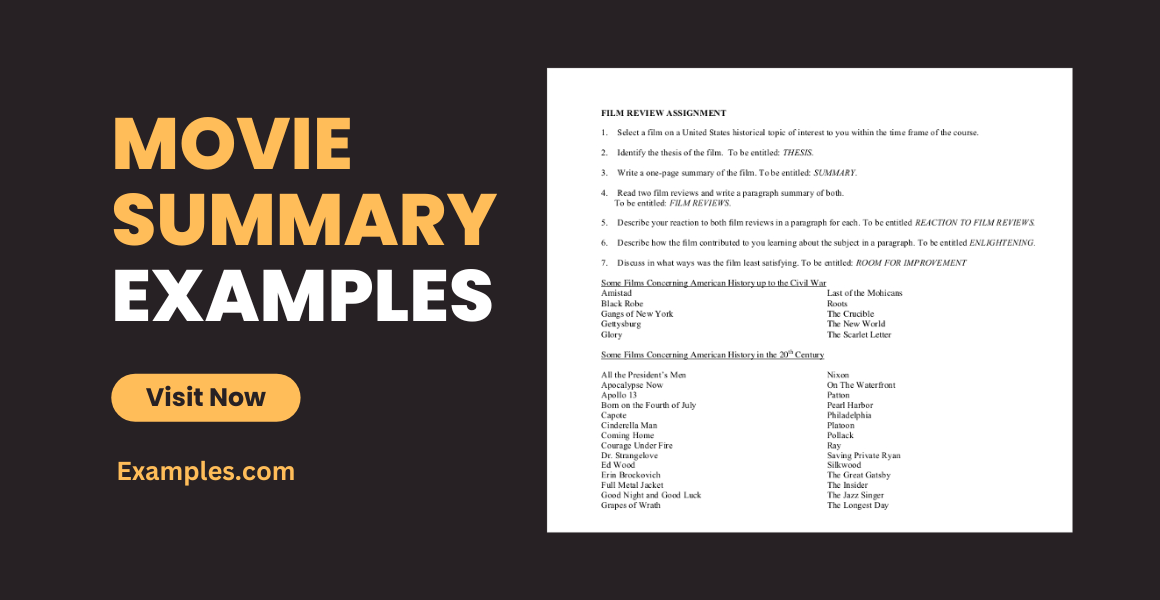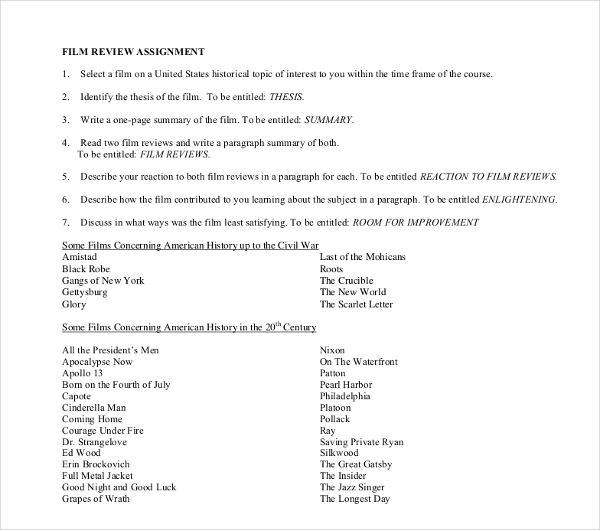Movie Summary Examples
If you want to know what the movie is about, you do not need to look any further since 21st century technology has already provided the masses with movie trailers that more or less give the whole story away without the directors and editors realizing it. There are some movie trailers that have actually piqued the audience’s interests without really giving away the story, further raising the curiosity of the crowd.
Take for instance, Star Wars: The Force Awakens. In all of the teasers and trailers that LucasFilm has released, it has only revealed portions of huge and epic space battles, lightsaber battles, and the return of a few familiar faces (cue in Han Solo and Chewbacca). The synopsis of the start of the new Star Wars film remained a mystery as the audience could not figure out the plot of what happened after Star Wars: The Return of the Jedi.

Although writing a film review is another topic entirely, it is not too far with that of writing a movie synopsis. Perhaps, the only difference is in the adding of your personal opinions on the film itself on what you have understood from the film, the lessons that you have acquired from it and what were some aspects of the film that could have been done better. Regardless, found below are examples of what a film review might look like should you choose to write one.
Film Review Assignment Summary Example
Guidelines of Writing an Effective Synopsis
Writing an original screenplay is tricky. One famous example would be Sylvester Stallone when he first handed out the script to play “Rocky”. Getting a director and a producer to see the true beauty and potential of the script takes time as only one thing comes to mind once they start funding the project for the script: How much is the return of investment going to be once we start shooting this movie? With that in mind, your screenplay must be able to knock the socks off the director and producer if you would really want your screenplay to be made into a movie.
- Length. Since what you are trying to write is a summary, all the important key details of the movie or screenplay should be found within the summary. Normally, the people reading this would only need to allocate four to five minutes before deciding whether your movie is a go or a no-go. Try aiming for two to three single-spaced pages. Some writers try to tell their story in a single page, but the results are usually so truncated as to be dry and lifeless. Go beyond three pages and you might risk losing the readers interest.
- Style. Although movies nowadays include many different point of views, (e.g. first-person and sometimes second-person), it is best to express it in the third person in the present tense. Remember, even in a summary, the purpose is for you to tell the story, not explain it. Every story has a beginning, a middle and an end. So make sure to include them in your summary. Unlike a full screenplay, however, a summary does not contain scene slugs or cinematic transitions.
- Characters. Other than the plot, the characters are the heart and soul of your screenplay or story. So make sure that when you introduce them, include memorable and crucial descriptions that define the character both physically and the kind of character he or she is. Remember, everyone loves a good story, but they adore the characters all the more. Take time to explain their motivations and emotional responses to some of the crises they face. Why characters do things is as vital to good storytelling as what they do and how they do it.
- Dialogue. Although this aspect has never really been added before, try doing so in order to give a bit of personality and life to your synopsis. A one-liner should be fine.
- Action. Who does not love a good action sequence. There are some synopses that are filled with action sequence. If you have been watching movie trailers that give you a glimpse of the movie itself, you may notice that some provide just the right amount of action. Not too much, and not too little as well.
- Subtext. Subtext — the meaning behind overt statements and actions — is usually verboten in screenplays, but they have their place in synopses. A good synopsis captures the emotional dynamics of the screenplay or short film it’s describing, and employing subtext is often effective in achieving this end.
Proven Strategies in Writing a Movie Summary
Now that you already have the basics, the big question remains: How will you make use of these guidelines to get results from the top brass? How can you increase the chances of the people reading that summary will eventually want to read your screenplay?
- Begin your synopsis with a logline. Before even starting to tell your story, it is always important to begin with a premise. This will set your readers’ expectations and allow them to better picture out the story you’re about to tell. Log lines should only contain one to two sentences as possible with a hint of irony if at all possible. After describing the events that have transpired at the end of Act I, a logline should include the protagonist(s), the protagonist’s central problem and a sense of what’s at stake. (Example: A put-upon teenage boy accidentally travels 30 years into the past where he inadvertently interferes with his mother and father’s first meeting. While trying to find a way back to the future, he must try to make his mismatched parents fall in love or he will never be born).
- Start with your lead character in motion. Everyone loves a good protagonist. At the beginning of the story, establish on what the main character is trying to achieve. Once you have that, make sure that the readers hooked up to it.
- Establish clear cause-and-effect connections. In The Lego Batman Movie, Batman faced with a difficult choice (not really) to let the Joker escape in his plastic gyrocopter or defuse the bomb that is threatening Gotham City and the rest of its yellow-bricked inhabitants. Fearing that the city will explode from underneath that will scramble all the Lego parts, Batman defuses the bomb and saves the day. In the same manner, it is important to develop a clear cause-and-effect relationships in the story that you are drafting to make the story more interesting that way.
- Focus on emotions. If you the protagonist is happy that the girl he loves and cares about is alive, how will you be able to express it so? “I love him” is not enough! The audience wants passion. They want all the feelings to come alive in the silver screen. Even as you write your summary, make it to a point that the director will be able to feel the emotions that you have placed in the story.
- Include your major set-pieces. Set-pieces are large, unified scenes of action, humor or drama. They are big sequences that make your screenplay unique and memorable. Take time to describe three or four big set-pieces, as these are ultimately your script’s biggest selling points, even though your synopsis is necessarily abbreviated.
- Think cinematically. Even before your movie hits the big screen, write it in a way that is meant for the big screen. Even if it is just a summary, do not hold back with the words that you are going to put in your summary (i.e. nouns, verbs, adverbs. adjectives, pronouns. etc.).
- Go Out with a bang. Start strong and end strong! Once you do, you will be able to sell your screenplay.
You may also want to take a look summary writing examples. Similar to writing a book summary, it is important to not to give too much of the plot away, otherwise you would ruin the mood for the audience in revealing some parts that are not meant to be revealed. When revealing the ending of the screenplay, make sure that all loose ends are tied. But if your intent is to surprise the audience into watching the movie every second just to find out the ending, then go ahead.
Movie summaries for promotional purposes can be served as content material for trailers. But if it is for academic purposes, then we would suggest to include the ending. Just recall this, in writing a movie synopsis, think of ways to continually surprise your audience.



